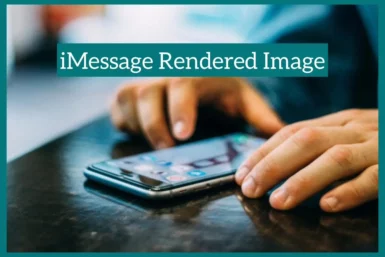Ever wondered about the meaning of ‘Rendered Image’ in an iMessage?
The article clarifies the mystery around this phrase, its purpose and explains how it differs from simple image sharing.
What Does Rendered Image Mean on iMessage?
Users are frequently confused by the term “Rendered Image” in iMessage. In basic terms, it describes the procedure of transforming input (in the form of code or another picture) into a finished, visible image.
Data is processed, or “rendered,” when you send a picture, a GIF, an Animoji, or a sticker via iMessage so that it will appear on the recipient’s screen.
Smooth, visually appealing interactions in our digital dialogues are made possible by a behind-the-scenes process.
The Role of Rendering
Rendering is essential to all oriented applications, including iMessage. It aids in properly presenting content by ensuring that pictures or animations are sized, positioned, and can be shown on various screens and devices.
Images received over iMessage are initially rendered as data, delivered over the internet, and then turned back into images on the recipient’s device.
Through a complex process, the sender may be confident the receiver will see the image exactly as they intended.
Impact on User Experience
The displayed image’s quality directly impacts the user experience. Images that are sharp, clear, and aesthetically pleasant have good rendering.
This rendering technique is continually being improved by Apple, which results in faster load times, less data usage, and a more seamless user experience.
Additionally, rendering enables the usage of tools like Animoji and Memoji, making iMessage more engaging and entertaining.
What is the Purpose of Rendering an Image?
The purpose for rendereing an image is as follows:
1. Improving Visual Presentation
Enhancing an image’s visual presentation is the main goal of rendering. Rendering converts unprocessed data or input into an aesthetically pleasing representation.
By considering elements like resolution, aspect ratio, color accuracy, and lighting effects, it makes sure that the image is displayed correctly. An image is made more visually appealing and delightful to behold through rendering.
2. Making Compatible Efforts
The goal of rendering is to maximize connectivity between various platforms and devices. Depending on the device’s capabilities, the size of the screen, and the software requirements, images must be rendered differently.
The image can be displayed correctly and consistently on various platforms, including smartphones, tablets, desktops, and other digital devices, by customizing the rendering method to fit certain devices.
3. Adding Animation and Interactivity
For visuals to be interactive and animated, rendering is essential. Rendering allows for the conversion of static images into dynamic ones with the addition of motion, transitions, and special effects.
This is especially important in the context of iMessage since features like Animoji and Memoji, which let users engage with emotes and animated characters during conversations, rely on rendering to build their characters.
4. Increasing User Satisfaction
In the end, producing an image enhances user experience in general. Users can take advantage of high-quality visuals that are aesthetically pleasing and interesting by ensuring that images are rendered appropriately and optimized for various devices.
Proper rendering improves photos’ clarity, sharpness, and integrity, making it more fun to view and share them within iMessage.
iMessage Rendered Images vs Simple Image Sharing
Rendering images is a distinctive feature that distinguishes iMessage from other messaging apps that just share images.
Users need to understand the differences between these two strategies in order to maximize their messaging experience.
| iMessage Rendered Images | Simple Image Sharing | |
|---|---|---|
| Image Quality | Optimized for visual appeal | Raw, unprocessed |
| Visual Presentation | Enhanced with rendering | Unmodified |
| Compatibility | Tailored for different devices | May have compatibility issues |
| Interactive Elements | Supports Animoji and Memoji | Static images |
| User Experience | Enhanced with engaging visuals | Basic and straightforward |
| Use Case | Personalized and dynamic content | Casual sharing or compatibility-focused scenarios |
Conclusion
In conclusion, understanding generated images in iMessage and contrasting them with simple image sharing illustrates the enormous impact on the user experience. The generated pictures used by iMessage provide the following:
- An improved visual display.
- Cross-platform interoperability.
- The inclusion of interactive elements like Animoji and Memoji.
In contrast, ordinary image sharing offers a quick and straightforward way to share photographs without the need for any specialized processing.
The precise setting, desired visual appeal, and the level of interactivity necessary will determine which of the two ways is best. Users may maximize the efficiency and enjoyment of their message exchanges by being aware of these distinctions and taking appropriate action.

